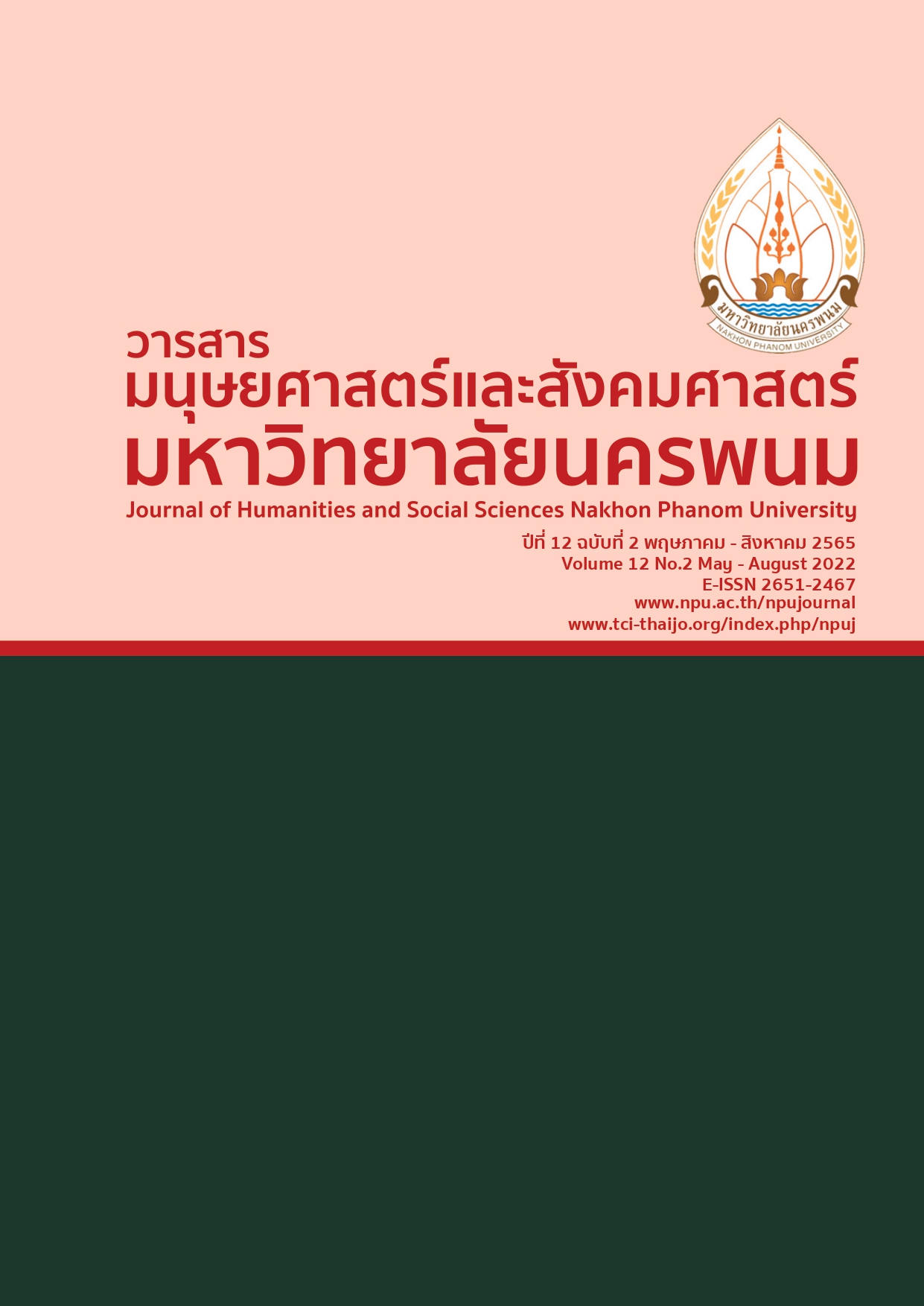Model of the Cultural Landscape Management in Samchuk Market, Suphanburi Province
Main Article Content
Abstract
The objective of this research is to guide the management of the cultural landscape at Suphanburi Province which will be suitable for the physical characteristics, and society as well as the culture in Samchuk market area. The study method collected both primary and secondary data. Field survey and observation To create a database of physical cultural landscapes up to date In-depth interviews with entrepreneurs on current physical issues and future trends Summary of the scope of the study background Then evaluate the cultural heritage value. and synthesize guidelines for area management presented in a mockup The simulation model asked the tourists' satisfaction and attitude towards the cultural landscape management approach. and summarize the results of the research. A combination of both quantitative and qualitative data collection methods. From the sample group, including 290 tourists. The tool used was a questionnaire. and an in-depth interview form, the sample group is 5 entrepreneurs within the Samchuk market by using a specific random method. The statistics used in the data analysis were percentage, mean, standard deviation. and descriptive analysis methods. It made it known that all 4 areas still had cultural landscape values in many aspects. The researchers realized the importance of such values. Therefore, the guidelines for the management of the physical cultural landscape are: (1) the approach to the management of the elements of the building cultural landscape. Structures and objects (2) Approaches for managing elements of cultural landscape in archaeological or historical areas (3) Approaches for managing elements of cultural landscapes in respect of vegetation (4) Approaches for managing elements of cultural landscapes in respect of micro-component. By offering an in-depth study to find a way to care to maintain Damaged parts must be restored or restored in the reconstructed part that does not correspond to the context of the original area and can also adjust the usefulness by modifying new activities into cultural areas as follows. (1) The road along Nathee, namely the area of the old wooden row house by the river Riverside Walkway, Old Ship Port Raft, Samchuk Market Sign, Chao Pho Samchuk Shrine building and shrine, especially in the area of Ylang Ylang, which is a hundred years old. (2) The municipal road Soi 1 is a wooden row house building, of gingerbread pattern which should be repaired. The area in front of the Pornpracha Bridge should be redesigned. (3) The municipal road Soi 2, including Ton Pho courtyard, Ban Khun Chamnong Chinarak Museum, Udomchok Hotel, Baan Tao Kae Seng are also in the Samchuk market area. (4) Mitr Samphan Road, including the old wooden row house arches, market signs, shop signs, road signs, publicity boards are also within the Samchuk market. The physical cultural landscape management approach is in line with the draft regulations for architectural conservation in the Samchuk market area.
Article Details

This work is licensed under a Creative Commons Attribution-NonCommercial-NoDerivatives 4.0 International License.
References
Anurak, T. (2017). phūm that watthanatham yān thanon rāt damnœ̄n ʻamphœ̄ mư̄ang čhangwat ืnakhō̜n sī tham rāt. [Cultural Landscape of Ratchadamnoen Road, Maung District, Nakhon Si Thammarat Province]. Veridian E-Journal Humanities, Social Sciences, and Arts Silpakorn University. 10(1), 2156-2172.
Asawakovitwong, N. (2005). yān talāt nưngrō̜i pī sāmchuk kap konkai chumchon nai miti kānʻanurak. [100 year market district, Samchuk and community mechanism in conservation dimension]. Thai Community Foundation. Bangkok: First print.
Buarapa, U. (2017). phūm that phư̄n thin khō̜ng chumchon bān hūanā Thai tambon nō̜ng khū khāt ʻamphœ̄bō̜rabư̄ čhangwat Maha Sarakham. [Vernacular Landscape of Ban Hua Na Thai Village, Kukad Sub-district, Borabue District, Maha Sarakham]. Built Environment Inquiry Journal Faculty of Architecture Khon Kaen University, Thailand. 16(1), 55-66.
Chaiyasit, V. and Suzhou, V. (2018).kānčhatkān phūm that watthanatham phư̄a kānthō̜ngthīeo.[Cultural Landscape Management for Tourism: A Case Study of Lamphun Railway Station]. Journal of Fine Arts. 9(1), 258-300.
Chumruksa, C., Niramol, K. and Suwanmanee, S. (2019). phūm that watthanatham sūn kānrīanrū chumchon withī khon nam pā khao pū [Cultural Landscapes of Khao Pu’s Community Learning Center on the Way of life, water and forest]. Journal of Education Thaksin University. 19(1), 115-133
Dechakhumphu, K. and Homdee, T. (2017). konkai kānmī sūanrūam khō̜ng chumchon nai kānčhatkān phư̄nthī sāthārana hāt hǣ ko̜ klāng mǣnam khōng. [Participatory Mechanism of Community in Public Area Management of Had Hae, the Mekong River Central Island]. Area Based Development Research Journal. Thailand Science Research and Innovation. 9(5), 347-360
Kaewyu, P. (2020). patčhai thī song phon tō̜ kānlư̄ak čhutmāiplāithāng khō̜ng nakthō̜ngthīeo thī dœ̄nthāng thō̜ngthīeo chœ̄ng hōihā ʻadīt nai phư̄nthī ʻamphœ̄ chumsǣng čhangwat ืNakhō̜n Sawan. [The Factors Affecting to Tourist’s selection as a Destination to Nostalgia Tourism in Chum Saeng district, Nakhonsawan Province]. 7th NEU National and International Conference North Eastern University (NEUNIC 2020) "Learning Innovation for Community Development” ; 1175-11850
Kamalanon, S. (2017). krabūankān čhatkān singwǣtlō̜m khō̜ng chumchon talāt sāmchuk čhangwat Suphan burī. [The Environmental Management Process of Samchuk Market Community, Suphanburi Province]. Panya Journal of MBU Lanna. 24(1), 8-17
Kookkaew, P. and Sanguansang, A. (2020). kān wikhro̜ sakkayaphāp khō̜ng talāt sāmchuk phư̄a rō̜ng rap kānthō̜ngthīeo yāng yangyư̄n. [Analysis the Potential of Samchuk Market to Support Sustainable Tourism]. Journal of Thai Hospitality and Tourism Siam University. 15(2), 68-76
Larpkern, W. and Poomdontree, R. (2018).phūm that watthanatham khō̜ng chāo sūan mư̄ang non. [The Cultural Landscape of Orchardists In Nonthabur]. Chandrakasem Rajabhat University Journal of Graduate School. 13(1), 21-31
Sukkai, S., Nuntasiri, P., Nomulkaew, T., Tanjaroenrat, K., Sermsri, S. and Luengtrairat, K. (2017). kānpramœ̄n khunkhā phūm that watthanatham khō̜ng mư̄ang Chīang Khō̜ng. [Culture Landscapes Evaluation of Chiang Khong City]. 3th National Conference of Architecture Khonkaen University “Assembling of : Wisdom to the future” ; 333-346
Suphanburi Provincial Tourism and Sports Office. (2018). sathiti nakthō̜ngthīeo [Tourist statistics]. Retrieved October 24, 2020, from https://suphanburi.mots.go.th/graph_views.php?graph_id=30.
Walker, M. (2013). The Illustrated Burra Charter: Good Practice for Heritage Places. 3 ed. Australia ICOMOS Peter: Marquis-Kyle.
Yamane, T. (1973). Statistics an introduction analysis. New York: Harper & Row.


